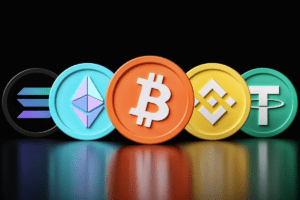Wprowadzenie do Solana
Aby zrozumieć Solanę, konieczne jest zrozumienie podstaw technologii blockchain i tego, jak zrewolucjonizowała ona różne branże.
Zrozumienie technologii Blockchain
Technologia blockchain to zdecentralizowany i rozproszony system rejestrów, który umożliwia bezpieczne i przejrzyste transakcje bez potrzeby korzystania z pośredników. Zapewnia on odporny na manipulacje zapis transakcji, który jest utrzymywany w wielu węzłach sieci. Technologia ta zyskała znaczną uwagę ze względu na swój potencjał do przekształcania branż takich jak finanse, łańcuch dostaw i opieka zdrowotna, między innymi.
Czym jest Solana?
Solana to blockchain o otwartym kodzie źródłowym platforma zaprojektowana z myślą o skalowalności i ograniczeniach wydajności tradycyjnych sieci blockchain. Jego celem jest zapewnienie wysokiej przepustowości, niskich opóźnień i bezpiecznej infrastruktury dla zdecentralizowanych aplikacji (dApps) i kryptowalut.
Zbudowana w oparciu o unikalne połączenie przełomowych technologii, Solana wykorzystuje kombinację algorytmów konsensusu Proof of History (PoH) i Proof of Stake (PoS), aby osiągnąć dużą szybkość transakcji i wysoką skalowalność.
Architektura Solany pozwala jej obsługiwać ogromną liczbę transakcji na sekundę, dzięki czemu nadaje się do aplikacji wymagających dużej przepustowości, takich jak zdecentralizowane finanse (DeFi), niewymienialne tokeny (NFT) i platformy do gier.
Wykorzystując połączenie innowacyjnych technik, Solana stała się obiecującym rywalem w ekosystemie blockchain. Ekosystem Solana składa się z różnych podstawowych komponentów i funkcji, które omówimy w następnej sekcji.
Aby zagłębić się w funkcje i aspekty techniczne Solany, można zapoznać się z dokumentem Biała księga Solana. Ponadto, aby uzyskać kompleksowy przegląd tokenomiki Solany i dystrybucji tokenów, zapoznaj się z naszym artykułem na temat Solana tokenomics.
Przejdźmy teraz do podstawowych komponentów i kluczowych funkcji ekosystemu Solana.
Ekosystem Solana
Aby zrozumieć Solanę, ważne jest zbadanie jej ekosystemu, który obejmuje różne podstawowe komponenty i funkcje, które wyróżniają ją w przestrzeni blockchain.
Główne komponenty Solana
Ekosystem Solana opiera się na kilku podstawowych komponentach, które płynnie ze sobą współpracują, zapewniając solidną i skalowalną platformę blockchain. Komponenty te obejmują:
-
Solana Mainnet: Solana Mainnet to sieć, w której transakcje są przetwarzane i zatwierdzane. Służy jako podstawa dla całego ekosystemu Solana, umożliwiając bezpieczne i wydajne operacje blockchain.
-
Żeton Solana: Token Solana jest natywną kryptowalutą sieci Solana. Odgrywa istotną rolę w ułatwianiu transakcji, motywowaniu uczestników sieci i zabezpieczaniu sieci poprzez tyczenie. Solana Tokenomics zapewnia dalszy wgląd w jego użyteczność i dystrybucję.
-
Solana Validators: Walidatorzy są kluczowymi uczestnikami ekosystemu Solana odpowiedzialnymi za walidację transakcji i utrzymanie integralności sieci. Zapewniają osiągnięcie konsensusu za pomocą innowacyjnych algorytmów konsensusu Proof of History (PoH) i Proof of Stake (PoS). Dowiedz się więcej o Solana Validators i ich znaczeniu w sieci.
-
Mapa drogowa Solana: Mapa drogowa Solany nakreśla przyszły kierunek i plany rozwoju ekosystemu. Podkreśla nadchodzące funkcje, ulepszenia i innowacje, które zwiększą wydajność, skalowalność i funkcjonalność łańcucha bloków Solana.
-
Solana Partnerships: Solana nawiązała strategiczne partnerstwa i współpracę z różnymi organizacjami i projektami w sektorach blockchain i technologii. Partnerstwa te mają na celu napędzanie adopcji, wspieranie innowacji i rozszerzanie przypadków użycia Solany w szerszym ekosystemie. Dowiedz się więcej o partnerstwach Solana i ich wpływie.
Kluczowe cechy ekosystemu Solana
Ekosystem Solana oferuje kilka kluczowych funkcji, które przyczyniają się do jego atrakcyjności i odróżniają go od innych platform blockchain:
-
Skalowalność i wysoka przepustowość: Solana została zaprojektowana do obsługi dużych wolumenów transakcji i osiągania krótkich czasów ich przetwarzania. Jego unikalna architektura, w tym funkcje takie jak Konsensus w sprawie Tower BFTUmożliwia skalowanie w poziomie, dzięki czemu nadaje się do wymagających zdecentralizowanych aplikacji i usług finansowych.
-
Niskie opłaty transakcyjne: Solana ma na celu zapewnienie opłacalnych transakcji poprzez zminimalizowanie opłat, uczynienie go bardziej dostępnym dla użytkowników i zapewnienie, że koszty transakcji pozostaną przystępne nawet podczas szczytowego wykorzystania sieci.
-
Efektywność energetyczna: Solana poczyniła znaczne postępy w optymalizacji zużycia energii, minimalizując swój wpływ na środowisko w porównaniu z tradycyjnymi platformami blockchain. Ta efektywność energetyczna została osiągnięta dzięki wydajnym algorytmom konsensusu i innowacyjnemu podejściu do przetwarzania transakcji.
Ekosystem Solana nieustannie ewoluuje, napędzany przez ciągłe wysiłki rozwojowe, udział społeczności i dążenie do najnowocześniejszych rozwiązań. Oczekuje się, że w miarę postępów Solana zrewolucjonizuje branżę blockchain, oferując nowe możliwości i szanse zarówno deweloperom, firmom, jak i użytkownikom. Bądź na bieżąco z najnowszymi osiągnięciami i postępami w ekosystemie Solana, odkrywając jego mapę drogową i angażując się w społeczność.
Algorytm konsensusu Solany
Aby zrozumieć wewnętrzne funkcjonowanie ekosystemu Solana, konieczne jest zbadanie algorytmu konsensusu, który go napędza. Solana wykorzystuje połączenie dwóch algorytmów konsensusu: Proof of History (PoH) i Proof of Stake (PoS).
Dowód historii (PoH)
Proof of History (PoH) to unikalna i innowacyjna koncepcja wprowadzona przez Solana. Działa on jak zegar kryptograficzny, który zapewnia historyczny zapis wydarzeń w sieci. PoH umożliwia Solanie porządkowanie i oznaczanie czasem transakcji bez konieczności uzgadniania dokładnej kolejności przez wszystkie węzły. To znacznie poprawia skalowalność i przepustowość sieci poprzez zmniejszenie narzutu komunikacyjnego.
Algorytm PoH działa poprzez tworzenie weryfikowalnej sekwencji znaczników czasu przy użyciu funkcji kryptograficznej o nazwie Verifiable Delay Function (VDF). Funkcja ta zapewnia, że znaczniki czasu są generowane w regularnych odstępach czasu, zapewniając wiarygodny i możliwy do skontrolowania zapis historyczny. Wykorzystując ten historyczny zapis, Solana osiąga szybkie i wydajne przetwarzanie transakcji.
Dowód stawki (PoS)
Proof of Stake (PoS) to kolejny istotny składnik algorytmu konsensusu Solana. W systemie PoS walidatorzy są wybierani do tworzenia nowych bloków i weryfikacji transakcji na podstawie liczby posiadanych tokenów, które są skłonni "postawić" jako zabezpieczenie. Im więcej tokenów postawi walidator, tym większe są jego szanse na wybranie go do utworzenia nowego bloku.
Wdrożenie PoS w Solanie pozwala na wydajne tworzenie i walidację bloków, zapewniając integralność i bezpieczeństwo sieci. Walidatory odgrywają kluczową rolę w utrzymaniu decentralizacji i konsensusu ekosystemu Solana. Aby dowiedzieć się więcej o walidatorach Solany, odwiedź nasz artykuł na stronie walidatory solana.
Łącząc Proof of History (PoH) i Proof of Stake (PoS), Solana osiąga wysoki poziom skalowalności, bezpieczeństwa i decentralizacji. Ten unikalny algorytm konsensusu odróżnia Solanę od innych platform blockchain i umożliwia jej obsługę znacznie wyższej przepustowości transakcji w porównaniu do tradycyjnych sieci blockchain.
Zrozumienie algorytmu konsensusu to tylko jeden z aspektów zrozumienia ekosystemu Solana. W kolejnych sekcjach zbadamy korzyści i zalety oferowane przez Solanę, a także jej rzeczywiste zastosowania w obszarach takich jak zdecentralizowane finanse (DeFi), niewymienialne tokeny (NFT) i gry.
Korzyści i zalety Solana
Jako innowacyjny ekosystem blockchain, Solana oferuje kilka znaczących korzyści i zalet, które odróżniają ją od innych platform. Zalety te obejmują skalowalność i wysoką przepustowość, niskie opłaty transakcyjne i efektywność energetyczną.
Skalowalność i wysoka przepustowość
Jedną z kluczowych zalet sieci Solana jest jej wyjątkowa skalowalność i wysoka przepustowość. Sieć Solana została zaprojektowana do obsługi dużej liczby transakcji na sekundę, dzięki czemu nadaje się do aplikacji wymagających szybkiego i wydajnego przetwarzania.
Solana osiąga tę skalowalność dzięki swojej unikalnej architekturze, która łączy w sobie kilka innowacyjnych mechanizmów. Mechanizmy te obejmują połączenie algorytmów konsensusu Proof of History (PoH) i Proof of Stake (PoS), a także zdecentralizowaną sieć walidatorów. Wykorzystując te techniki, Solana może osiągnąć wysoką przepustowość transakcji, umożliwiając szybkie i niezawodne wykonywanie inteligentnych kontraktów i zdecentralizowanych aplikacji (dApps).
Aby umieścić to w kontekście, sieć Solana jest w stanie przetwarzać tysiące transakcji na sekundę, dzięki czemu doskonale nadaje się do aplikacji wymagających interakcji w czasie rzeczywistym i szybkiego przetwarzania danych. Więcej informacji na temat skalowalności Solany można znaleźć w naszym artykule na temat skalowalność solana.
Niskie opłaty transakcyjne
Oprócz skalowalności, Solana oferuje również niskie opłaty transakcyjne, dzięki czemu jest opłacalna dla użytkowników. Wydajny projekt sieci Solana pozwala na przetwarzanie dużej liczby transakcji przy niskich kosztach, zapewniając użytkownikom możliwość dokonywania transakcji i interakcji z blockchainem bez ponoszenia wygórowanych opłat.
Niskie opłaty transakcyjne w sieci Solana są szczególnie korzystne dla użytkowników angażujących się w częste transakcje lub korzystających ze zdecentralizowanych aplikacji. Ta przystępna cena sprawia, że Solana jest atrakcyjną opcją dla programistów i firm, które chcą budować na platformie blockchain bez obciążenia wysokimi kosztami transakcji.
Efektywność energetyczna
Efektywność energetyczna to kolejna godna uwagi zaleta ekosystemu Solana. W przeciwieństwie do niektórych innych sieci blockchain, które opierają się na energochłonnych mechanizmach konsensusu, takich jak Proof of Work (PoW), Solana wykorzystuje energooszczędny algorytm konsensusu Proof of Stake (PoS).
Przechodząc na PoS, Solana znacznie zmniejsza zużycie energii i ślad węglowy w porównaniu z tradycyjnymi blockchainami opartymi na PoW. To energooszczędne podejście jest zgodne z rosnącym globalnym naciskiem na zrównoważony rozwój i zmniejsza wpływ na środowisko związany z technologią blockchain.
Wykorzystując swój energooszczędny mechanizm konsensusu, Solana zapewnia bardziej zrównoważoną platformę dla programistów i użytkowników do tworzenia i interakcji ze zdecentralizowanymi aplikacjami. To zaangażowanie w efektywność energetyczną wyróżnia Solanę w ekosystemie blockchain.
Korzyści i zalety oferowane przez Solanę, w tym jej skalowalność, niskie opłaty transakcyjne i efektywność energetyczna, sprawiają, że jest ona atrakcyjnym wyborem dla programistów, firm i użytkowników poszukujących szybkiej, opłacalnej i zrównoważonej platformy blockchain. W miarę jak Solana ewoluuje i zyskuje na popularności, jej potencjał do powszechnego przyjęcia i wpływu na różne branże staje się coraz bardziej widoczny.
Przypadki użycia i zastosowania Solany
Ponieważ Solana nadal zyskuje na popularności w przestrzeni blockchain, jej wszechstronny ekosystem oferuje różne przypadki użycia i aplikacje. Przyjrzyjmy się trzem ważnym obszarom, w których Solana wywiera znaczący wpływ: zdecentralizowane finanse (DeFi), niewymienialne tokeny (NFT) oraz gry i wirtualne światy.
Zdecentralizowane finanse (DeFi)
Wysoka przepustowość Solany i niskie opłaty transakcyjne sprawiają, że jest to idealna platforma dla zdecentralizowanych aplikacji finansowych (DeFi). DeFi odnosi się do zestawu aplikacji finansowych opartych na technologii blockchain, które mają na celu odtworzenie i ulepszenie tradycyjnych systemów finansowych bez pośredników.
W sieci Solana protokoły DeFi mogą ułatwiać takie działania, jak udzielanie pożyczek, handeli uprawy plonów. Duża szybkość przetwarzania transakcji, osiągnięta dzięki skalowalnej architekturze Solana, umożliwia płynne korzystanie z usługi i efektywne zarządzanie płynnością. Dzięki skupieniu się Solany na skalowalności i wysokiej przepustowości, projekty DeFi zbudowane na blockchainie Solana mogą obsługiwać dużą liczbę transakcji na sekundę, zapewniając użytkownikom płynne i opłacalne doświadczenie DeFi.
Tokeny niewymienialne (NFT)
Innym prężnie rozwijającym się obszarem w ekosystemie Solana jest wykorzystanie niewymienialnych tokenów (NFT). NFT to unikalne aktywa cyfrowe, które reprezentują własność lub dowód autentyczności konkretnego przedmiotu, niezależnie od tego, czy jest to sztuka, muzyka, wirtualne nieruchomości czy przedmioty kolekcjonerskie.
Szybki czas potwierdzenia transakcji i niskie opłaty sprawiają, że Solana jest atrakcyjną opcją dla twórców i kolekcjonerów w przestrzeni NFT. Artyści mogą wybijać i sprzedawać swoje cyfrowe dzieła sztuki na platformach NFT opartych na Solanie, podczas gdy kolekcjonerzy mogą bezpiecznie kupować i sprzedawać swoje cyfrowe dzieła sztuki na platformach NFT opartych na Solanie. handel NFT z łatwością. Wysoka przepustowość sieci Solana zapewnia, że rynki NFT mogą obsługiwać dużą liczbę transakcji, zapewniając płynne doświadczenie zarówno twórcom, jak i kupującym.
Gry i wirtualne światy
Skalowalność i niskie opóźnienia sieci Solana sprawiają, że doskonale nadaje się ona do gier i aplikacji wirtualnych światów. Sieć Solana umożliwia deweloperom tworzenie zdecentralizowanych platform do gier i wirtualnych światów z interakcjami w czasie rzeczywistym i niemal natychmiastowymi potwierdzeniami transakcji.
Wykorzystując wysoką przepustowość Solany, twórcy gier mogą tworzyć wciągające doświadczenia, które mogą obsługiwać dużą liczbę graczy jednocześnie. Niskie opłaty transakcyjne Solana zapewniają, że transakcje w grze, takie jak kupowanie wirtualnych aktywów lub handel przedmiotami, mogą być przeprowadzane w opłacalny sposób.
Co więcej, szybki czas potwierdzania bloków Solana pozwala na interakcje w czasie rzeczywistym w wirtualnych światach, zapewniając płynne i wciągające wrażenia z gry. Ekosystem Solana stanowi idealną podstawę do rozwoju zdecentralizowanych aplikacji do gier, wspierając innowacje i kreatywność w branży gier.
Wszechstronność Solana wykracza poza te trzy przypadki użycia, z potencjalnymi zastosowaniami w obszarach takich jak zarządzanie łańcuchem dostaw, przechowywanie danych i wiele innych. Ponieważ ekosystem Solana nadal ewoluuje, możliwości innowacji i adopcji w różnych branżach są ogromne.
Aby dowiedzieć się więcej o technicznych aspektach Solany, sprawdź stronę Biała księga Solana. Aby uzyskać najnowsze informacje na temat planu działania i partnerstw Solany, odwiedź nasz artykuł na stronie Partnerstwa Solana.
Przyszłość Solany
Ponieważ Solana nadal zyskuje uznanie i rozpęd w społeczności blockchain, jej przyszłość niesie ze sobą zarówno potencjalne wyzwania, jak i ekscytujące możliwości rozwoju.
Potencjalne wyzwania
Chociaż Solana sprawdziła się jako skalowalna i wysokowydajna platforma blockchain, nie jest ona pozbawiona potencjalnych wyzwań. Jednym z głównych wyzwań, przed którymi może stanąć Solana, jest rosnąca konkurencja ze strony innych platform blockchain. Wraz z ewolucją przestrzeni blockchain pojawiają się nowe platformy, z których każda ma własne unikalne funkcje i możliwości. Solana będzie musiała nadal wprowadzać innowacje i różnicować się, aby utrzymać się na czele tego konkurencyjnego krajobrazu.
Kolejnym wyzwaniem, jakie może napotkać Solana, jest potrzeba utrzymania silnej i zdecentralizowanej sieci walidatorów. Walidatory odgrywają kluczową rolę w zabezpieczaniu sieci Solana i walidacji transakcji. W miarę rozwoju sieci konieczne będzie zapewnienie zróżnicowanego i solidnego zestawu walidatorów w celu utrzymania integralności i bezpieczeństwa ekosystemu. Więcej informacji na temat walidatorów można znaleźć w naszym artykule na temat walidatory solana.
Perspektywy i potencjał wzrostu
Pomimo potencjalnych wyzwań, perspektywy Solany pozostają pozytywne, a jej potencjał wzrostu jest znaczący. Ekosystem Solana zyskał już uwagę i wsparcie różnych graczy z branży, w tym deweloperów, inwestorów i instytucji. Imponująca skalowalność, wysoka przepustowość i niskie opłaty transakcyjne sprawiają, że jest to atrakcyjna opcja dla zdecentralizowanych aplikacji (dApps), zdecentralizowanych finansów (DeFi), niewymienialnych tokenów (NFT) i aplikacji do gier.
Mapa drogowa Solany przedstawia kilka ekscytujących zmian i inicjatyw, które mają kształtować jej przyszłość. Obejmuje to ciągłe badania i rozwój w celu dalszego zwiększenia skalowalności, bezpieczeństwa i funkcjonalności platformy. Zaangażowanie Solana w ciągłe doskonalenie i innowacje zapewnia jej dobry rozwój i przyjęcie w przyszłości. Aby dowiedzieć się więcej o mapie drogowej Solana, odwiedź nasz artykuł na stronie mapa drogowa solana.
Co więcej, strategiczne partnerstwa i współpraca Solany z różnymi projektami i organizacjami przyczyniają się do jej potencjału wzrostu. Nawiązując sojusze z liderami branży i wspierając innowacyjne projekty, Solana dąży do rozszerzenia swojego ekosystemu i przyciągnięcia różnorodnych aplikacji i użytkowników. Aby poznać partnerstwa Solana, zapoznaj się z naszym artykułem na temat solana partnerships.
W miarę dojrzewania i ewolucji Solana ma potencjał, by stać się znaczącym graczem w przestrzeni blockchain. Jej zaawansowane funkcje, energooszczędność i przyjazne dla deweloperów środowisko sprawiają, że jest ona atrakcyjnym wyborem dla osób i firm chcących wykorzystać technologię blockchain. To, czy Solana w pełni wykorzysta swój potencjał i stanie się główną platformą blockchain, dopiero się okaże, ale jej dotychczasowe postępy pokazują jej możliwości i stanowią solidną podstawę do przyszłego rozwoju.



